Gold Coins
Gold has served as the basis of many currencies throughout history. In America, gold coins were among the earliest pieces issued. In fact, three gold denominations – the Eagle ($10), Half Eagle ($5), and Quarter Eagle ($2.50), were authorized under the original Mint Act of 1792. Passed on April 2, this Act authorized the first U.S. Mint and our country's coin denominations.
Gold Dollars
Soon after gold was discovered in California, the first gold coin with the denomination of one dollar was struck, bearing James B. Longacre's Liberty Head design. This 90% gold coin depicted Liberty wearing a coronet on the obverse. The reverse features a wreath surrounding the date and denomination. Liberty Head dollars were struck from 1849-1854, when they were replaced by the Indian Princess type.
Also designed by James B. Longacre, the new dollar's obverse featured the profile of an Indian Princess wearing a feathered headdress. The reverse design was similar to the one on the earlier dollar – a wreath around the denomination and date – though slightly modified. This was America's last one dollar gold coin, and was issued until 1889.
See our Gold Dollar inventory
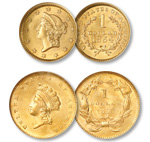
The Liberty Head and Indian Princess gold dollars were both designed by James B. Longacre.

The first Capped Bust design was issued from 1796 to 1807.

The Classic Head Quarter Eagle, issued in a smaller size, contained less gold than its predecessors.

Designer Christian Gobrecht's Liberty Head Quarter Eagle was produced for 67 years.

The Indian Head design was incused, or recessed, into the coin.
Quarter Eagles
Authorized under the original Mint Act of 1792, the first quarter eagles ($2.50) were issued in 1796. They featured Robert Scot's rendition of Liberty in a cloth cap facing right on the obverse, while the reverse displayed a heraldic eagle. Struck in 91.67% pure gold, this design (which bore no statement of denomination) was issued until 1807.
In 1808, the quarter eagle was redesigned by John Reich. The coin still showed Liberty in a cloth cap, now facing left. On the reverse was a redesigned heraldic eagle, above the denomination (shown as 2 1/2 D.). No quarter eagles were struck from 1809-1820. The same design was issued again from 1821-1834.
Following the Act of June 28, 1834, the weight of gold coins was reduced. At this same time, a new design by William Kneass debuted on the quarter eagle. Called the Classic Head, this gold coin features the profile of Liberty with her hair tied in a band. The eagle on the reverse was perched with wings outstretched and a shield on its breast. This design stood until 1839.
Liberty Head quarter eagles of 1840-1907 boasted Christian Gobrecht's rendition of Liberty with her hair tied in a bun. The eagle on the reverse was the same design as on the previous Classic Head gold coins. The final quarter eagle debuted in 1908. Designed by Bela Lyon Pratt, this all-new design showed the profile of an Indian Chief on the obverse, with an eagle standing proud on the reverse. In a departure from previous coinage, the design was incused – recessed into the coin. This final quarter eagle design was last issued in 1929.
See our Gold Quarter Eagle inventory
Three Dollar Gold
From 1854-1889, a unique denomination – the three dollar gold piece – was issued. Their original purpose was to make it easier to purchase sheets of 100 postage stamps (which were just 3¢ then). These coins featured James B. Longacre's Indian Princess design, also found on the gold dollar of the same time frame. On the reverse, a wreath encircled the denomination and date.
See our Three Dollar Gold inventory
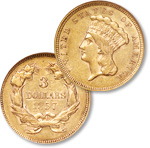
The Three Dollar gold piece features the Indian Princess design also found on later gold one-dollar coins.
Half Eagles
One of the first coins authorized under the Mint Act of 1792, the first $5 half eagle was also America's first gold coin in circulation. Designed by Robert Scot, the original Capped Bust obverse design showed Liberty in a cloth cap. On the reverse, an eagle stands with wings spread, holding a wreath in its beak. This design was issued until 1798. That year, the coin's reverse was changed to a heraldic eagle. However, earlier obverse dies were combined with the new reverse design, resulting in Capped Bust with heraldic eagle coins dated from 1795-1807.
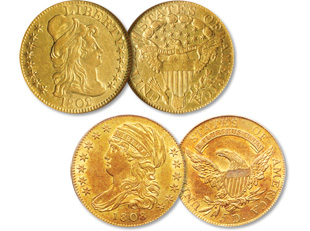
Early Half Eagle designs: Scot's Capped Bust with Heraldic Eagle reverse, and Reich's Capped Bust
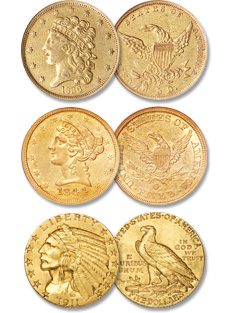
Classic Head, Liberty Head, Indian Head Half Eagle designs followed Quarter Eagles of similar time frames.
From 1807-1812, John Reich's Capped Bust design debuted. Liberty is shown on the obverse, her hair covered by a cloth cap. The eagle on the reverse is perched on a branch, holding three arrows in its talons. In 1813, the obverse design was replaced by a slightly modified depiction of Liberty, also by John Reich. This gold coin design was continued until 1834, when it was replaced by the Classic Head.
Designed by William Kneass, the 1834-1838 Classic Head coinage was similar to that of the quarter eagle of the same time frame, issued in the diameter and weight of the $5 gold coinage. The same held for Christian Gobrecht's 1839-1908 Liberty Head Eagle, and Bela Lyon Pratt's 1908-1929 incused Indian Head design, which also followed quarter eagles of similar time frames.
See our Gold Half Eagle inventory
Eagles
Designs on $10 eagle gold coins followed a similar pattern to America's smaller denomination gold coins. The early $10 gold coin designs were:
- 1795-1797 Capped Bust (Small Eagle reverse)
- 1797-1804 Capped Bust (Heraldic Eagle reverse)
- 1838-1866 Liberty Head (no motto above eagle)
- 1866-1907 Liberty Head (motto above eagle)
The 1907-1933 Indian Head gold Eagle design differed from the earlier quarter and half eagle designs. Designed by Augustus Saint-Gaudens, the obverse of this stunning coin displays Liberty in a Native American headdress. A perched eagle adorns the reverse.
See our Gold Eagle inventory

Capped Bust design with Heraldic Eagle reverse
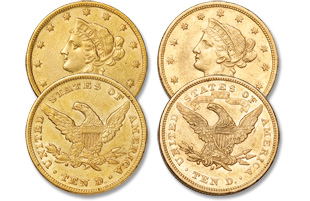
The motto in god we trust was added to the reverse of the Liberty Head design in 1866.
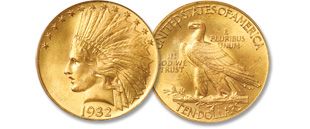
The Indian Head design was the last $10 gold coin produced.
Double Eagles
The largest of all regular-issue U.S. coins, $20 gold pieces were introduced in 1849 during the California gold rush. First designed by James B. Longacre, the original Liberty Head double eagle depicted Liberty with her hair in a bun, adorned by a coronet inscribed liberty. An ornamented eagle is on the reverse, with stars and rays above. This design continued with slight modifications until 1907, when one of America's most famous coin designs debuted.

The Liberty Head Double Eagle was produced until 1907, when it was replaced by Saint‑Gaudens' popular design.
Designed by Augustus Saint-Gaudens, the $20 Double Eagle gold coin of 1907-1933 is considered by many to be the most beautiful coin design in U.S. history. The obverse features a bold depiction of Liberty striding forward. Behind her is a depiction of the Capitol building and rays. On the reverse, an eagle flies past a sun with rays. This design was issued through 1933, when all gold coinage was suspended following the gold recall of 1933.
See our Gold Double Eagle inventory
Read more...

